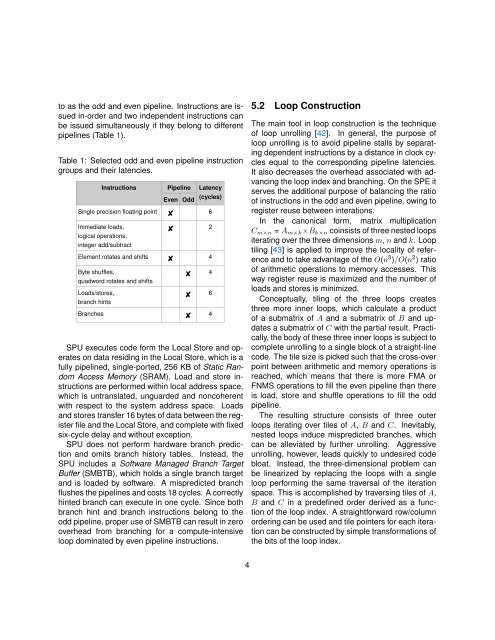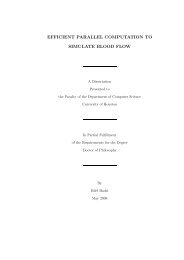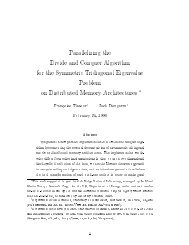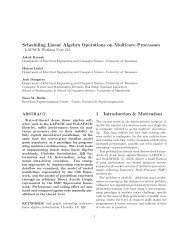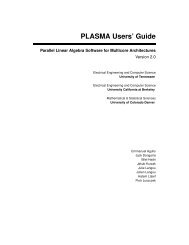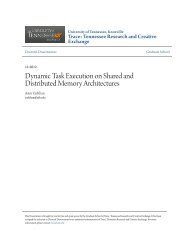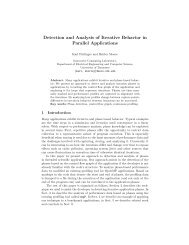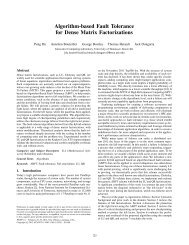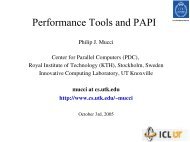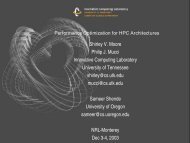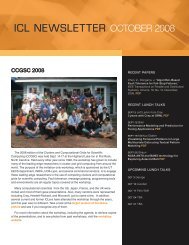Fast and Small Short Vector SIMD Matrix Multiplication ... - The Netlib
Fast and Small Short Vector SIMD Matrix Multiplication ... - The Netlib
Fast and Small Short Vector SIMD Matrix Multiplication ... - The Netlib
You also want an ePaper? Increase the reach of your titles
YUMPU automatically turns print PDFs into web optimized ePapers that Google loves.
to as the odd <strong>and</strong> even pipeline. Instructions are issued<br />
in-order <strong>and</strong> two independent instructions can<br />
be issued simultaneously if they belong to different<br />
pipelines (Table 1).<br />
Table 1: Selected odd <strong>and</strong> even pipeline instruction<br />
groups <strong>and</strong> their latencies.<br />
Instructions<br />
Pipeline<br />
Even Odd<br />
Latency<br />
(cycles)<br />
Single precision floating point<br />
<br />
6<br />
Immediate loads,<br />
logical operations,<br />
integer add/subtract<br />
<br />
2<br />
Element rotates <strong>and</strong> shifts<br />
<br />
4<br />
Byte shuffles,<br />
quadword rotates <strong>and</strong> shifts<br />
Loads/stores,<br />
branch hints<br />
<br />
4<br />
<br />
6<br />
Branches<br />
<br />
4<br />
SPU executes code form the Local Store <strong>and</strong> operates<br />
on data residing in the Local Store, which is a<br />
fully pipelined, single-ported, 256 KB of Static R<strong>and</strong>om<br />
Access Memory (SRAM). Load <strong>and</strong> store instructions<br />
are performed within local address space,<br />
which is untranslated, unguarded <strong>and</strong> noncoherent<br />
with respect to the system address space. Loads<br />
<strong>and</strong> stores transfer 16 bytes of data between the register<br />
file <strong>and</strong> the Local Store, <strong>and</strong> complete with fixed<br />
six-cycle delay <strong>and</strong> without exception.<br />
SPU does not perform hardware branch prediction<br />
<strong>and</strong> omits branch history tables. Instead, the<br />
SPU includes a Software Managed Branch Target<br />
Buffer (SMBTB), which holds a single branch target<br />
<strong>and</strong> is loaded by software. A mispredicted branch<br />
flushes the pipelines <strong>and</strong> costs 18 cycles. A correctly<br />
hinted branch can execute in one cycle. Since both<br />
branch hint <strong>and</strong> branch instructions belong to the<br />
odd pipeline, proper use of SMBTB can result in zero<br />
overhead from branching for a compute-intensive<br />
loop dominated by even pipeline instructions.<br />
5.2 Loop Construction<br />
<strong>The</strong> main tool in loop construction is the technique<br />
of loop unrolling [42]. In general, the purpose of<br />
loop unrolling is to avoid pipeline stalls by separating<br />
dependent instructions by a distance in clock cycles<br />
equal to the corresponding pipeline latencies.<br />
It also decreases the overhead associated with advancing<br />
the loop index <strong>and</strong> branching. On the SPE it<br />
serves the additional purpose of balancing the ratio<br />
of instructions in the odd <strong>and</strong> even pipeline, owing to<br />
register reuse between interations.<br />
In the canonical form, matrix multiplication<br />
C m×n = A m×k ×B k×n coinsists of three nested loops<br />
iterating over the three dimensions m, n <strong>and</strong> k. Loop<br />
tiling [43] is applied to improve the locality of reference<br />
<strong>and</strong> to take advantage of the O(n 3 )/O(n 2 ) ratio<br />
of arithmetic operations to memory accesses. This<br />
way register reuse is maximized <strong>and</strong> the number of<br />
loads <strong>and</strong> stores is minimized.<br />
Conceptually, tiling of the three loops creates<br />
three more inner loops, which calculate a product<br />
of a submatrix of A <strong>and</strong> a submatrix of B <strong>and</strong> updates<br />
a submatrix of C with the partial result. Practically,<br />
the body of these three inner loops is subject to<br />
complete unrolling to a single block of a straight-line<br />
code. <strong>The</strong> tile size is picked such that the cross-over<br />
point between arithmetic <strong>and</strong> memory operations is<br />
reached, which means that there is more FMA or<br />
FNMS operations to fill the even pipeline than there<br />
is load, store <strong>and</strong> shuffle operations to fill the odd<br />
pipeline.<br />
<strong>The</strong> resulting structure consists of three outer<br />
loops iterating over tiles of A, B <strong>and</strong> C. Inevitably,<br />
nested loops induce mispredicted branches, which<br />
can be alleviated by further unrolling. Aggressive<br />
unrolling, however, leads quickly to undesired code<br />
bloat. Instead, the three-dimensional problem can<br />
be linearized by replacing the loops with a single<br />
loop performing the same traversal of the iteration<br />
space. This is accomplished by traversing tiles of A,<br />
B <strong>and</strong> C in a predefined order derived as a function<br />
of the loop index. A straightforward row/column<br />
ordering can be used <strong>and</strong> tile pointers for each iteration<br />
can be constructed by simple transformations of<br />
the bits of the loop index.<br />
4


